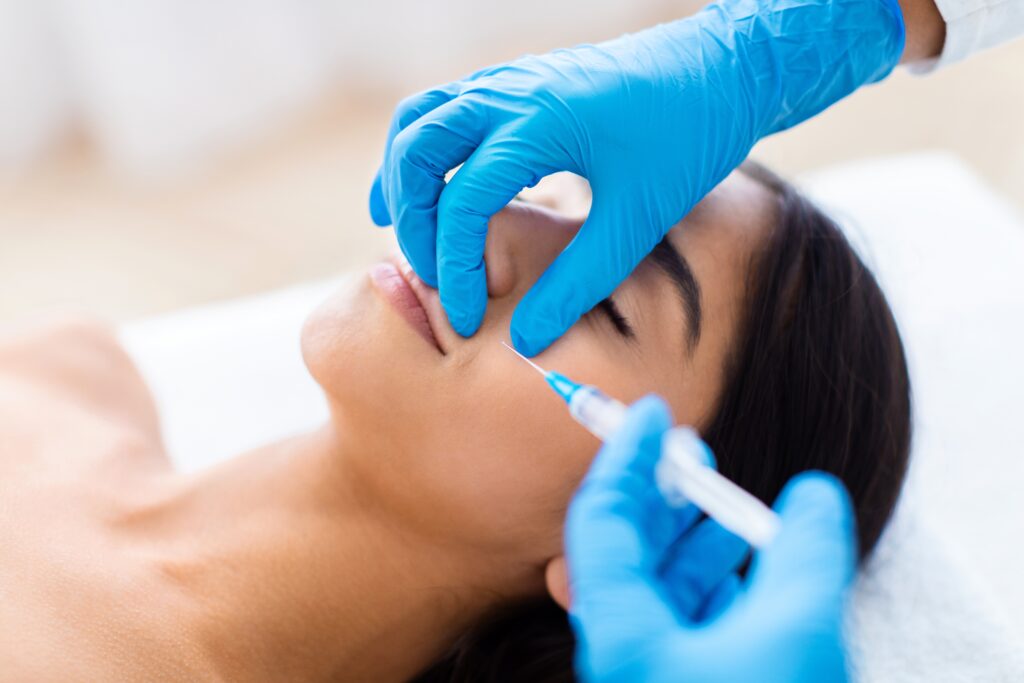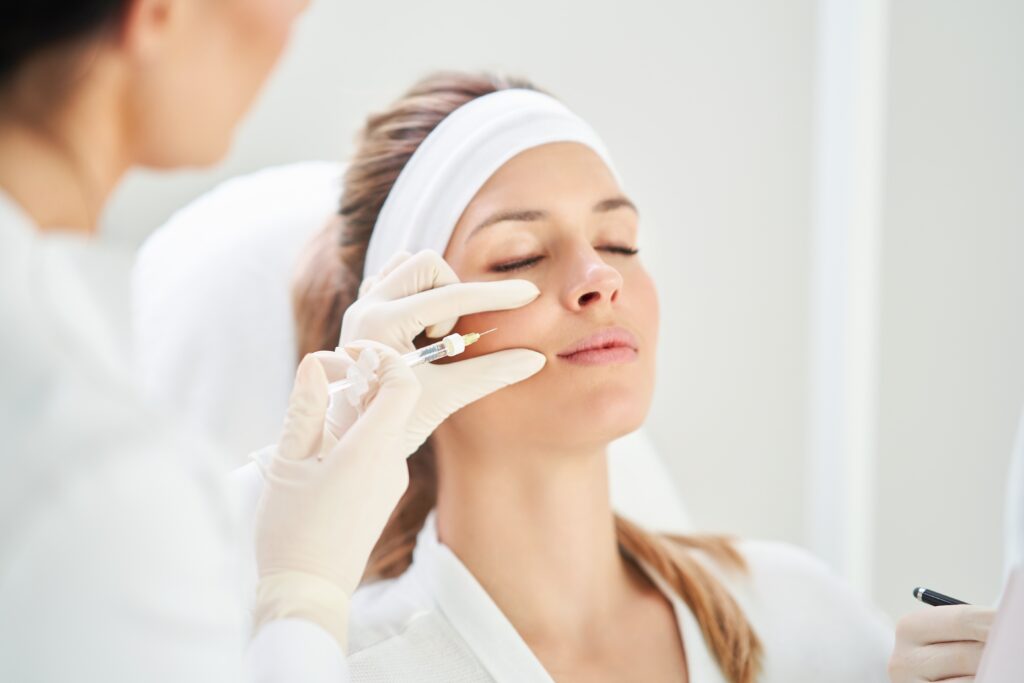
Xeomin®, Dysport®, and Botox® are all injectable treatments that belong to a class of medications called neuromodulators that use the same main ingredient, botulinum toxin type A. When used for cosmetic purposes, botulinum toxin type A injectables help reduce the appearance of wrinkles and fine lines by temporarily paralyzing or relaxing the facial muscles, depending on the treatment zone. However, while their main function is similar, these injectables each possess a few unique traits that are worthy of consideration.
What Are Botox®, Xeomin®, and Dysport®?
When people think about injectable cosmetic treatments, Botox® is usually the first product that comes to mind, mostly due to its long history and excellent results at minimizing wrinkles and rejuvenating the appearance of the skin. However, Botox® is not the only option for those who want to reduce the appearance of fine lines and wrinkles by using neuromodulator treatments. Let’s take a look at each of these popular treatment options in a bit more detail.
Botox: An Overview
The Food and Drug Administration (FDA) first approved Botox® for cosmetic treatment in 2002. For more than 20 years since that time, Botox® has stood the test of time as the poster child for safe, effective, non-surgical aesthetic treatments, and it remains the most popular neuromodulator treatment in use today. Botox® is actually the brand name of onabotulinum toxin A, a specific type of botulinum toxin A that is notable for its effectiveness and ability to deeply target specific areas of the face.
The FDA has approved Botox® for the cosmetic treatment of forehead lines, crow’s feet, and other facial lines. The injections are also used “off-label” for other cosmetic purposes, such as jaw and neck Botox® treatments to address issues like sagging skin and double chins. In addition, Botox® is FDA-approved for use as a medical treatment for some conditions, including migraines, excessive sweating, strabismus, and cervical dystonia.
Dysport®: An Overview
For many patients, Dysport® is interchangeable with Botox® for the treatment of facial lines and wrinkles. FDA-approved since 2009, Dysport® is a bit newer to the U.S. market as compared to Botox®, which may be why it is less popular that Botox® in the states. However, it’s been successfully used in Europe since the 1990s.
Although its primary ingredient is also botulinum toxin A, Dysport® differs from Botox® in terms of its additional ingredients. Additionally, some studies suggest that Dysport® produces a slightly longer lasting effect.
Xeomin®: An Overview
The newest neuromodulator injectable on the market is Xeomin®, which gained FDA approval in 2011. Like Dysport®, the main differentiator between Xeomin® and its competitors is its molecular makeup. Xeomin® lacks any type of complex protein additive (present in both Botox® and Dysport®), making it a more “naked” or “pure” type of botulinum toxin injection.
What Is the Difference Between Xeomin®, Dysport®, and Botox® Injectables?
While each of the three neuromodulators, Botox®, Dysport®, and Xeomin®, have the same main ingredient and treat the same main cosmetic concerns, they each offer a slightly different list of performance features. Evaluating these differences is an important step in determining which injectable is right for you.
Composition and Purity
The base of Botox®, Dysport®, and Xeomin® is made up of different strains of botulinum toxin A, the most popular and common type of neurotoxin. The botulinum toxin is responsible for freezing or relaxing the facial muscles in a way that helps smooth out the appearance of fine lines and wrinkles. However, the strain of botulinum toxin A that each product uses is slightly different, which may lead to slightly different effects, depending on the patient.
In addition, each of the three products contains different additives on top of the botulinum toxin. Botox® and Dysport®, for example, use a complex protein to help bind the botulinum toxin. In addition, Dysport® also contains additional inhibitors and blockers that can improve its effectiveness and treatment range. By contrast, Xeomin® is more of a “naked” or pure neuromodulator, with minimal additional ingredients other than its main botulinum toxin.
Administration and Injection Techniques
Understandably, the different formulations of Botox® vs. Dysport® vs. Xeomin® can affect the administration and injection techniques that practitioners use to treat individuals with each of these neuromodulators. In the case of all three options, practitioners will inject the product into a targeted muscle area using a very fine needle. The injections must be shallow and precise to ensure the recipient achieves the desired results.
Practitioners may tailor their injection techniques based on a patient’s facial anatomy, desired outcomes, and the specific areas being treated. It’s also important to note that the specific technique used may depend on the individual practitioner’s preferences, treatment experience, and typical patient outcomes.
Onset of Action and Duration of Effect
The onset and duration of results from all three of these neuromodulators can vary slightly based on both their composition and the individual patient’s treatment plan, desired results, and genetics. Some people report that Dysport® may have a slightly quicker onset compared to Botox®, while Xeomin® has an onset time that is similar to Botox®. All three neuromodulators last for about three to four months for most patients, although individual genetic factors — metabolism, in particular — can affect this duration.
Ideal Candidates for Each Treatment
The ideal candidate for Botox®, Dysport®, or Xeomin® is generally someone who wants to reduce the appearance of wrinkles and fine lines caused by common, repeated muscle movements in the face, such as smiling or frowning. However, individual considerations and preferences may influence the choice between these neuromodulators. Because all three have similar effects, some patients choose to switch between toxins in order to prevent antibodies or long-term resistance to a single product.
Schedule a Consultation
Whether you are a devoted fan of Botox®, Dysport®, or Xeomin®, or even if you have never had an injectable treatment and need help understanding which treatment is the best option for you, The Rejuva Center at Williams in Albany, NY, can help. Our experienced practitioners are well versed in the different formulations of Botox® vs. Dysport® vs. Xeomin®, and they are standing by to help you decide which treatment option you prefer to achieve your desired results. Schedule a consultation today to learn more.
Recent Posts

Reversing Smoking Damage to Your Skin
Smoking can cause significant skin damage, affecting both overall skin health and its appearance. However, smoking damage can be severe, but there are ways to reverse skin damage caused by…

Balancing Holistic Practices with Cosmetic Treatments
A holistic approach to beauty, including focusing on lifestyle, nutrition, and mental well-being, contributes to skin health as well as general healthiness. Combining holistic practices like these with the non-surgical…

A Complete Guide to the Cosmetic Treatment Process: Start to Finish
Non-surgical cosmetic treatments are a great way to revive your look in a safe and effective manner, without the risks associated with surgery. Since 1999, The Rejuva Center at Williams…

Am I Too Young for Botox®?
Botox®, or botulinum toxin, is a popular cosmetic procedure used to reduce the appearance of wrinkles and fine lines by temporarily paralyzing the underlying muscles. Approved by the Food and…